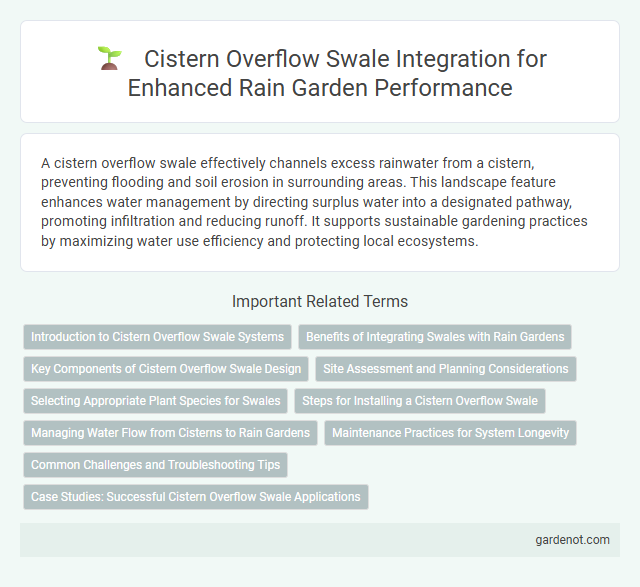A cistern overflow swale effectively channels excess rainwater from a cistern, preventing flooding and soil erosion in surrounding areas. This landscape feature enhances water management by directing surplus water into a designated pathway, promoting infiltration and reducing runoff. It supports sustainable gardening practices by maximizing water use efficiency and protecting local ecosystems.
Introduction to Cistern Overflow Swale Systems
Cistern overflow swale systems manage excess rainwater by directing overflow from cisterns into a shallow, vegetated channel that promotes infiltration and reduces runoff. These systems enhance stormwater management by mimicking natural hydrology, improving groundwater recharge, and preventing erosion. Incorporating native plants in the swale supports biodiversity while maintaining effective water filtration and flow control.
Benefits of Integrating Swales with Rain Gardens
Integrating cistern overflow swales with rain gardens enhances stormwater management by effectively capturing and directing excess runoff, reducing the risk of flooding and erosion. This combination improves groundwater recharge and filters pollutants, promoting healthier urban ecosystems. Swales paired with rain gardens increase landscape aesthetics while supporting biodiversity through native plantings.
Key Components of Cistern Overflow Swale Design
Cistern overflow swale design integrates a graded depression that directs excess rainwater away from storage tanks, minimizing flooding risks. Key components include a perforated pipe system to facilitate controlled drainage, native vegetation for filtration and erosion control, and an engineered soil mix that promotes infiltration while ensuring structural stability. Incorporating these elements enhances water quality, reduces runoff velocity, and supports groundwater recharge within urban rain garden systems.
Site Assessment and Planning Considerations
Site assessment for cistern overflow swales involves evaluating soil permeability, topography, and drainage patterns to ensure effective water infiltration and prevent erosion. Planning considerations include determining appropriate swale dimensions, slope gradients, and selecting native vegetation to maximize water absorption and pollutant filtration. Careful analysis of overflow volumes and connection to existing stormwater systems is essential to design a functional and sustainable rain garden component.
Selecting Appropriate Plant Species for Swales
Selecting appropriate plant species for cistern overflow swales is essential for effective water filtration and erosion control. Native grasses, sedges, and flowering perennials with deep root systems enhance soil infiltration and stabilize the swale structure. Choosing drought-tolerant, low-maintenance plants that thrive in both wet and dry conditions ensures long-term swale functionality and ecological balance.
Steps for Installing a Cistern Overflow Swale
To install a cistern overflow swale, begin by assessing the landscape slope and mapping the overflow path from the cistern to the swale location. Excavate the swale channel to a depth of 6-12 inches, ensuring a gentle gradient for water flow, then line it with permeable materials like gravel or mulch to promote infiltration. Finally, connect the cistern overflow pipe securely to direct excess water into the swale, and plant native vegetation along its edges to stabilize soil and enhance stormwater absorption.
Managing Water Flow from Cisterns to Rain Gardens
A cistern overflow swale efficiently channels excess water from cisterns directly into adjacent rain gardens, preventing flooding and soil erosion. This engineered landscape feature uses gentle grading and native vegetation to slow water flow, enhance infiltration, and maximize groundwater recharge. Properly designed cistern overflow swales improve stormwater management by integrating rainwater harvesting systems with sustainable garden ecosystems.
Maintenance Practices for System Longevity
Regular inspection and removal of sediment in the cistern overflow swale prevent clogging and ensure efficient water flow. Vegetation management, including timely trimming and replanting with native species, supports soil stabilization and reduces erosion. Seasonal checks for debris accumulation and repair of any infiltration issues enhance system longevity and maintain optimal rain garden performance.
Common Challenges and Troubleshooting Tips
Cistern overflow swales often face challenges such as soil erosion, poor drainage, and clogging from debris or sediment buildup. Regular maintenance includes inspecting for sediment accumulation, ensuring proper slope to avoid water pooling, and reinforcing eroded areas with native vegetation or erosion control mats. Addressing these issues promptly enhances water infiltration and prevents overflow damage in rain garden systems.
Case Studies: Successful Cistern Overflow Swale Applications
Cistern overflow swales effectively manage excess rainwater, preventing flooding and promoting groundwater recharge in urban landscapes. Case studies from Portland and Seattle demonstrate significant reductions in stormwater runoff and improved water quality through integrated cistern overflow swale designs. These projects highlight the importance of site-specific planning and native vegetation in enhancing swale performance and ecosystem benefits.
Cistern overflow swale Infographic

 gardenot.com
gardenot.com